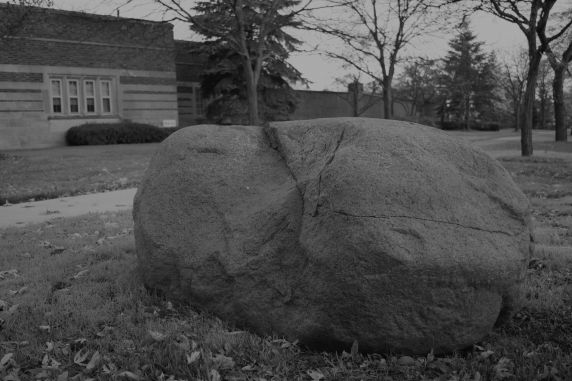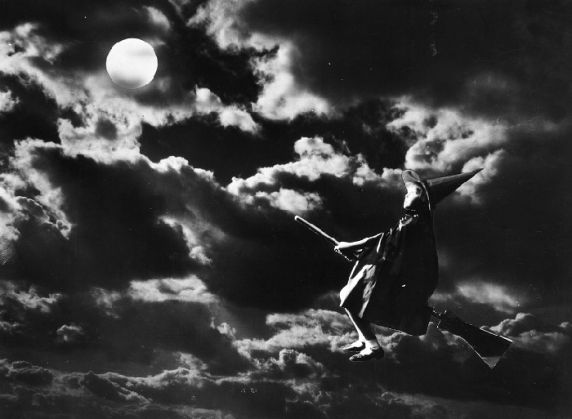Folklore Fridays: Halloween Edition
Halloween is nearly upon us and what better way to celebrate the long, dark nights to come than through an exploration of Detroit’s supernatural landscape?
While looking through the heading of “supernatural” in the Folklore Index, one finds a mixture of beliefs and stories shared from the traditions of indigenous tribes and communities, European immigrants, African-Americans, families relocated from the South, and urban legend. The following stories are excerpts from interviews and analysis contained in student field work projects for the Folklore Archive. Some of the themes you may recognize, while others are remarkably singular. The names of the interviewees have been redacted for the sake of privacy.
“The Werewolf of Grosse Pointe” [ref: 1993 (4)]
French settlers brought much to the area by way of folklore, with one of the most well known of these stories taking place in the area now known as Grosse Pointe. The story of the Loup Garou (werewolf), dates back to the 17th-century and involves a pious maiden, dark magic, and werewolf paw print entombed in stone. As the story moved into modern times, the circumstances of it changed, as seen in this version collected by Ron DiCiccio in 1978.
“[Interviewee] indicated to me that he remembers this legend. His memory dictates that, on the day of marriage of a young Grosse Pointe couple, and after the wedding ceremony and during the partying time of the reception, a werewolf invaded the reception and spirited away the new bride. The new husband and all the guests were shocked and dazed for a few minutes as to the present happening. After they composed themselves, they  immediately ran after the werewolf and the new bride. However, they were never able to find any trace of them. However, the trail did lead them down to the water shoreline. It was interesting to note that this evening was a fully moonlit night. The water was at low tide. One of the guests noticed that at the water’s edge was a large boulder that appeared to be shining in the moonlight. Because of the brightness, it drew everyone’s attention to it. Curiosity being what it is, the guests immediately inspected the large boulder. Yes, they were able to see something they felt was left by the werewolf. To this day, no one can confirm or deny that the footprint was left there by the werewolf or the new bride.”
immediately ran after the werewolf and the new bride. However, they were never able to find any trace of them. However, the trail did lead them down to the water shoreline. It was interesting to note that this evening was a fully moonlit night. The water was at low tide. One of the guests noticed that at the water’s edge was a large boulder that appeared to be shining in the moonlight. Because of the brightness, it drew everyone’s attention to it. Curiosity being what it is, the guests immediately inspected the large boulder. Yes, they were able to see something they felt was left by the werewolf. To this day, no one can confirm or deny that the footprint was left there by the werewolf or the new bride.”
“The Ghost of Tanglewood Bridge” [ref: 1969 (200)]
The following is part of an analysis of a story collected by Dave Sprybrook in 1969, and involves a haunting on Belle Isle. It is a classic “white lady” story in which a woman in white haunts a location in search of something lost.
“The story of the ghost of Tanglewood Bridge on Belle Isle concerns a young lady who was in an accident on or around the bridge and was thrown through the window of the car and onto the rocks below the bridge in the woods. The ghost involved, however, is not the young lady killed in the accident, but rather her mother who comes to the bridge each night  to search for her daughter. The lady always seems to come back around midnight each night dressed completely in white. ...the mother was coming back to look for her daughter who had been killed. The ghost is always seen on the bridge or in the woods surrounding the bridge. The ghost sometimes comes right up to the car to look into the car to see if her daughter is in the car ….and may tap on the window of the car to try and get in.”
to search for her daughter. The lady always seems to come back around midnight each night dressed completely in white. ...the mother was coming back to look for her daughter who had been killed. The ghost is always seen on the bridge or in the woods surrounding the bridge. The ghost sometimes comes right up to the car to look into the car to see if her daughter is in the car ….and may tap on the window of the car to try and get in.”
A white lady of Tanglewood Drive is also known to respond to young drivers who honk three times into the night by trying to lure them into the woods. Urban legend has her as the mother of a girl who was murdered on that stretch of road. Other folklore has her as the daughter of Chief Sleeping Bear, placed on the island for her own protection and given the gift of immortality and the ability to change into a white doe. Coincidence? The island is now a State Park which closes long before midnight, thus the world may never know.
"Ghostlore in Detroit" [1966-8-8 (88)]
The student field projects collected both "known" lore, like the two stories prior, and personal accounts from everyday people. Janet McMahon included several of the later type in her work in 1966, including this next story of a friend's unexpected visit by a ghostly relative.
“My brother was born at 8:30 in the morning, October 29, 1929. He was born at home on Bryden Street in Detroit. Doctor left at 10:30. Mother was in bed and saw a shadow of smoke or steam come over to the crib. It was in the form of an old lady. It came into the room from the hall and looked like the shape of an old lady. It bent over the crib like a woman looking at a baby then was gone. Mother checked, but there was nothing in the house that could have caused smoke or steam. She wasn’t afraid, but she sort of doubted her own senses. That night they got a telegram saying that great-grandmother had died in Arkansas at 9:30 that morning. Mother always said that [grandma] wanted to see the oldest son of the oldest son before she left for good.”
“Cures and Ghost Tales” [1966-8-8 (90)]
These final stories and anecdotes, drawn from a transcript, were collected by B.D. Buckner in 1966 from a woman who was living on McClellan Street. They are her personal encounters and recollections involving a restless mother, a helpful witch, and a good reason to ignore your dog. Note: The numbers associated with the stories refer to their location within the appendix.
8. “Before I lived on Larned, a woman died in the house where I moved. My cousin Martha Ann and her son came to visit me. Martha Ann’s son saw and described the dead woman perfectly, and he’d never seen her [alive]. He described Rex’s wife and ain’t never seen her; she pulled the covers off the boy every night. I know he saw her ‘cause he described her to me. Big old woman with long plaits. The child told it just as plain as day, that was Rex’s wife. I put a cross in there and she quit visiting. Martha Ann used to whip her son because she thought he was lying. But that woman has been dead for three years--long before that boy got there. The woman was coming back to see her baby. That was her baby’s room; that where he was sleeping when she died.”
10a. “A witch lived with my grandmama. My grandma had fourteen children, and she did all the work. Every night the witch helped my grandma put the children to bed. The witch left her skin hanging on the wall and told my grandma not to let anybody touch the skin or she knew what would happen. Every night she went to the store, got everything (food) out of the store except silver money. She fed the whole family. My aunt will tell you that. This old witch came by and asked for a place to stay. My grandma let her in and she stayed forever [until] one day she just went away. My grandma was scared to let her stay and scared to tell her to go. I heard if you put salt down, they’ll go away but grandma was scared s--t--s of that woman. The witch stayed there and took care of the children until the kids got grown. My oldest auntie said the skin hung on the wall, and they knew not to touch it. That wasn’t no joke. Don’t care how my Grandma locked that door, don’t care how late, when grandma woke up, the witch was hauling in groceries.”
13. “Whenever a dog barks and whines and cries, he’s looking at a ghost.”
Try not to think too much about that last one. Happy Halloween!
Folklore Fridays is an exploration of a theme or topic found within the Folklore Archive through text, audio, or still imagery. It appears on the Reuther Library blog on the last Friday of each month. The Folklore Archive, established in 1939, contains the oldest and largest record of urban folk traditions in the United States.
Elizabeth Clemens is an Audiovisual Archivist at the Walter P. Reuther Library.



 Reddit
Reddit Facebook
Facebook LinkedIn
LinkedIn